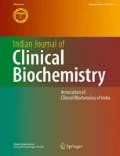Abstract
The antidyslipidemic activities of Tinospora cordifolia (T. cordifolia): family Menispermaceae, Hindi name: Giloya; Gurch or Tinospora in english, extract have been studied in alloxan induced diabetic rats. In this model, oral administration of stem extract (500 mg/kg bw. p.o.) for 30 days resulted significant decreased in the levels of blood glucose, plasma lipids and reactivated post heparin lipoprotein lipase activity in alloxan induced diabetic rats. Furthermore, the stem extract (50–500 μg) when tested for its antioxidant activity, shown to inhibit the generation of super oxide anions and hydroxyl radicals, in both enzymic and non-enzymic systems in vitro. The results of the present study demonstrated antidyslipidemic and antioxidant activities of T. cordifolia which could help in prevention of diabetic-dyslipidemia and related complications.
References
Kumar V, Mahdi F, Chander R, Khanna AK, Husain I, Singh R, Saxena JK, Mehdi AA, Singh RK. Tinospora cordifolia regulates lipid metabolism in alloxan induced diabetic rats. Int J Pharm Life Sci. 2013;4:3010–7.
Rajalakshmi M, Eliza J, Priya CE, Nirmala A, Daisy P. Anti-diabetic properties of Tinospora cordifolia stem extracts on streptozotocin- induced diabetic rats. Afr J Pharm Pharmacol. 2009;3:171–80.
Purandare H, Supe A. Immunomodulatory role of Tinospora cordifolia as an adjuvant in surgical treatment of diabetic foot ulcers: a prospective randomized controlled study. Indian J Med Sci. 2007;61:347–55.
Dhingra D, Jindal V, Sharma S, Harna RK. Evaluation of antiobesity activity of Tinospora cordifolia stem in rats. Int J Res Ayurveda Pharm. 2011;2:306–11.
Mohammed K, Ali KM, Narayan V, Tandon N. Diabetes and coronary heart disease: current perspectives. Indian J Med Res. 2010;130:584–97.
Tamboli SB, Sontakee SP, Parsode RB. Study of hypoglycemic activity of Tinospora cordifolia in alloxan induced diabetic rats. Int J Basic Clin Pharmacol. 2013;2(5):559–61.
American Diabetes Association. Management of dyslipidemia in adults with diabetes (Position Statement). Diabetes Care. 2003;26:S83–6.
Chattopadhyaya R, Pathak D, Jindal DP. Antihyperlipidemic agents: a review. Indian Drugs. 1996;33:85–97.
Mittal J, Sharma MM, Batra A. Tinospora cordifolia: a multipurpose medicinal plant—a review. J Med Plant Stud. 2014;2(2):32–47.
Trinder P. Determination of glucose in blood using glucose oxidase with an alternative oxygen acceptor. Ann Clin Biochem. 1969;6:24–30.
Deeg R, Ziegenborn J. Kinetic enzymatic method for automated determination of total cholesterol in serum. Clin Chem. 1983;29:1798–803.
Zilversmith DB, Davis DK. Micro determination of plasma phospholipids by trichloroacetic acid precipitation. J Lab Clin Med. 1950;35:155–60.
Buccolo G, David H. Quantitative determination of serum triglyceride by the use of enzymes. Clin Chem. 1973;19:476–80.
Mosinger F. Photometric adaptation of Dole’s microdetermination of free fatty acids. J Lipid Res. 1965;6:157–9.
Wing DR, Robinson DS. Clearing factor lipase in adipose tissue. Biochem J. 1968;29:1798–803.
Okhawa H, Qohishi N. Assay for lipid peroxides in animal tissues by thiobarbituric acid reaction. Anal Biochem. 1978;95:351–8.
Bindoli A, Valante M, Cavallin L. Inhibition of xanthine oxidase and xanthine dehydrogenase activity. Pharmacol Res Commun. 1985;17:831–9.
McCord JM, Fridovich IJ. Superoxide dismutase; an enzymic function for erythrocuprein (hemocuprein). J Biol Chem. 1969;244:6049–55.
Richmond R, Halliwell R, Chauhan J, Darbre A. Suproxide dependent formation of hydroxyl radical by hydroxylation of aromatic compounds. Anal Biochem. 1981;118:320–35.
Halliwell B, Gutteridge JMC, Aroma OI. The deoxyribose method: a simple test tube assay for determination of rate constants for reaction OH− radicals. Anal Biochem. 1987;165:215–9.
Woodson RF. Statistical methods for the analysis of biochemical data. Chichester: Wiley; 1957. p. 315.
Trivedi NA, Mazumdar B, Bhatt JD, Hemavathi KG. Effect of Shilajit on blood glucose and lipid profile in alloxan induced diabetic rats. Indian J Pharmacol. 2004;36:373–6.
Das S. Current understanding of risk factors and mechanisms in the pathogenesis of macrovascular disease in diabetes mellitus. Indian Acad Clin Med. 2001;2:214–21.
Prince PSM, Menon VP. Short communications : hypoglycemic and Hypolipidaemic action of alcohol extract of Tinospora cordifolia roots in chemical induced diabetes in rats. Phytother Res. 2003;17:410–3.
Sangeetha MK, Balaji HR, Gaythri V, Vasanthi HR. Tinospora cordifolia attenuates oxidative stress and distorted carbohydrate metabolism in experimentally induced type 2 diabetes in rats. J Nat Med. 2011;65:544–50.
Sankhala LN, Saini RK, Saini BS. A review of chemical and biological properties of Tinospora cordifolia. Int J Med Aroma Plants. 2012;2:340–4.
Author information
Authors and Affiliations
Corresponding author
Rights and permissions
About this article
Cite this article
Kumar, V. Antidyslipidemic and Antioxidant Activities of Tinospora cordifolia Stem Extract in Alloxan Induced Diabetic Rats. Ind J Clin Biochem 30, 473–478 (2015). https://doi.org/10.1007/s12291-015-0485-1
Received:
Accepted:
Published:
Issue Date:
DOI: https://doi.org/10.1007/s12291-015-0485-1

